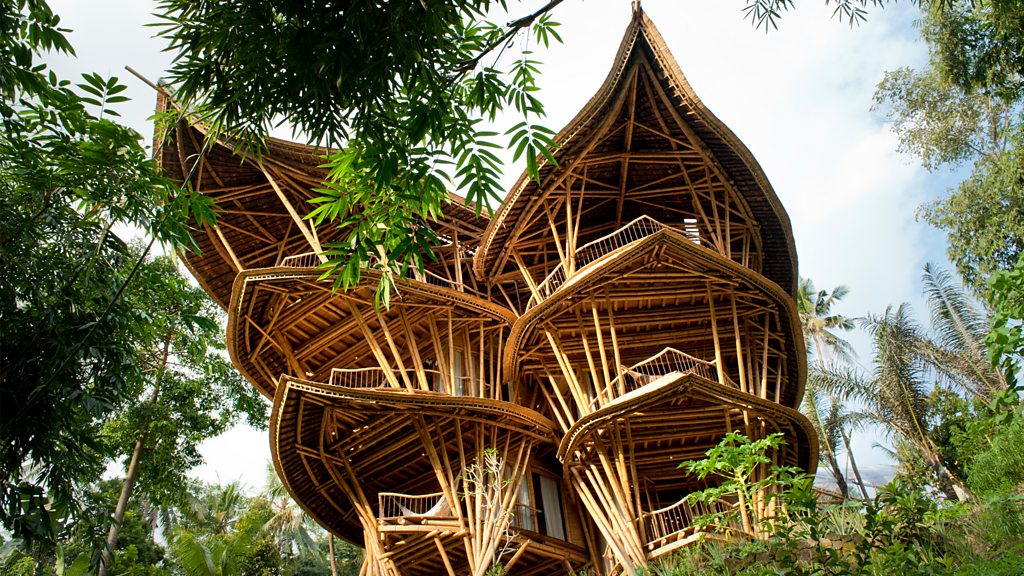In the heart of Bali, Indonesia, lies an architectural marvel that redefines the boundaries of sustainable living and design: The Green Village (Link). This holistic eco-village, founded on the principles of environmental harmony and innovative design, represents the vision of John Hardy and his daughter, Elora Hardy, along with their design firm, Ibuku (Link). In this exploration, we delve into the architectural genius behind The Green Village, its foundation on bamboo’s versatility, and the Hardys’ mission to create a sustainable future through design.
The Architectural Vision: Bamboo as the Soul of Design
At the core of The Green Village’s architectural ethos is the unparalleled use of bamboo, championed by John and Elora Hardy and brought to life by the creative minds at Ibuku. This design team has transcended traditional architectural concepts, treating bamboo not just as a material but as the very soul of their design philosophy. The structures within The Green Village curve and flow with organic grace, challenging the conventions of modern architecture and offering a living testament to bamboo’s strength, flexibility, and beauty.
John and Elora Hardy: Pioneers of Sustainable Design
The inception of The Green Village was driven by John Hardy, a visionary who, after retiring from a successful jewelry business, sought to make a significant impact on sustainable living. In 2008, he founded The Green School (Link) together with his wife Cyntia. His vision was crystallized through the architectural ingenuity of his daughter, Elora Hardy, who left her career in New York to join the mission in Bali. Together, they founded Ibuku, an innovative design firm dedicated to elevating bamboo from a traditional material to the foundation of groundbreaking architectural projects. Their work at The Green Village is a showcase of their commitment to environmental stewardship, community building, and the transformative power of design.
Ibuku: Innovators in Bamboo Architecture
Ibuku’s approach to design is rooted in a deep respect for nature and the potential of bamboo. The firm’s architects, designers, and craftsmen work closely with the material, understanding its nuances and capabilities to create structures that are not only environmentally sustainable but also aesthetically stunning. Each home and building in The Green Village is custom-designed, seamlessly integrating with the landscape and embodying a philosophy of living that is in harmony with the natural world.
Sustainable Practices and Innovations
Beyond its bamboo architecture, The Green Village integrates a variety of sustainable practices and innovations. Solar energy powers the community, while natural water filtration systems and rainwater harvesting techniques emphasize a self-sustaining ethos. Ibuku’s designs also incorporate natural ventilation, minimizing the need for air conditioning and reducing the village’s carbon footprint. These elements, combined with the organic gardens that supply residents with fresh produce, exemplify a holistic approach to eco-friendly living.

In 2022, I stayed at The Green Village for a couple of unforgettable days. © Credit: M. Hoppe
Educational Outreach and Global Influence
The Green Village and Ibuku extend their impact beyond Bali through educational programs, workshops, and tours that share their knowledge and innovations in sustainable design (Link https://greenvillagebali.com/visit/ ). By educating visitors and professionals from around the world, they are spreading the message of sustainability and inspiring others to consider eco-friendly practices in architecture and daily life.
Strong Community Ethos
More than a collection of beautiful homes, Green Village epitomizes a shared ethos among its residents – a collective commitment to sustainable living and an appreciation for the luxury of nature. The community thrives on connection, hosting regular events and gatherings that foster a sense of belonging. Through these interactions, residents enjoy the comfort and reassurance of being part of a community that values harmony with nature as much as they do.
Conclusion: A Visionary Blueprint for the Future
Through the story of The Green Village, John, Cynthia & Elora Hardy, and the groundbreaking work of Ibuku, we are reminded of the power of visionary architecture to create positive change. This remarkable community not only offers a blueprint for sustainable living but also stands as a source of inspiration for those seeking to blend design, functionality, and environmental stewardship. As we navigate the challenges of the modern world, let The Green Village in Bali inspire us to envision and build spaces that respect the earth and elevate our spirits.























